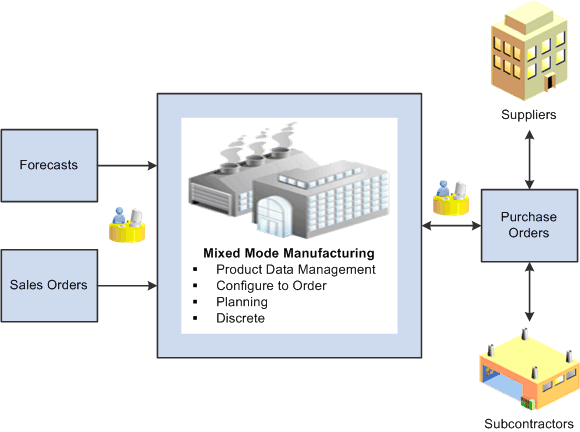2 Understanding JD Edwards EnterpriseOne Project Manufacturing
This chapter contains the following topics:
-
Section 2.1, "JD Edwards EnterpriseOne Project Manufacturing Overview"
-
Section 2.2, "Limitations of JD Edwards EnterpriseOne Project Manufacturing"
2.1 JD Edwards EnterpriseOne Project Manufacturing Overview
Companies can meet country and industry business requirements while improving customer satisfaction by providing visibility to the customer's demand throughout the manufacturing process. Companies that manage customer orders from entry to shipment ensure on-time, high-quality delivery of the final end product.
The JD Edwards EnterpriseOne Project Manufacturing product from Oracle supports a manufacturing methodology in which orders and inventory associated to a customer order are tracked using a unique production number. You define items as production controlled and then label inventory and orders with a unique production number.
JD Edwards EnterpriseOne Project Manufacturing enables you to:
-
Separate inventory by customer demand.
-
Enable visibility and trackability of the customer order throughout the manufacturing process.
-
Respond quickly to customer changes.
JD Edwards EnterpriseOne Project Manufacturing supports production controlled items in distribution and manufacturing industries. JD Edwards EnterpriseOne Project Manufacturing integrates with other JD Edwards EnterpriseOne systems from Oracle to create a complete supply chain solution. Companies can use JD Edwards EnterpriseOne Project Manufacturing to effectively manage customer orders throughout their entire supply chain.
This diagram illustrates the integrated solution for JD Edwards EnterpriseOne Project Manufacturing:
Figure 2-1 Integrated Solution for JD Edwards EnterpriseOne Project Manufacturing

Description of ''Figure 2-1 Integrated Solution for JD Edwards EnterpriseOne Project Manufacturing''
The business processes for production controlled items can be more complex than those for standard manufactured items because of the production numbers associated with production controlled items.
The JD Edwards EnterpriseOne Inventory Management system integrates with JD Edwards EnterpriseOne Project Manufacturing to define and manage production controlled items. JD Edwards EnterpriseOne Project Manufacturing enables you to view, adjust, issue, and transfer production controlled items.
The JD Edwards EnterpriseOne Sales Order Management system integrates with JD Edwards EnterpriseOne Project Manufacturing to associate production numbers with customer orders at sales order entry.
The JD Edwards EnterpriseOne Forecast Management system integrates with JD Edwards EnterpriseOne Project Manufacturing to generate and revise forecasts for production controlled items.
|
Note: The JD Edwards EnterpriseOne system allows only one type of top-level demand for production controlled items with an associated production number at any instant in time, either a forecast or a sales order. If a production controlled item has a forecast, then the item with the same production number cannot have a sales order. |
The JD Edwards EnterpriseOne Requirements Planning system integrates with JD Edwards EnterpriseOne Project Manufacturing to support material planning for production controlled items. You can process messages manually or automatically. The system also supports production controlled items in the supplier release scheduling process.
After you enter production controlled items, bills of material, and routings, you can use programs in the JD Edwards EnterpriseOne Shop Floor Management system to complete the manufacture of production controlled items. The JD Edwards EnterpriseOne Shop Floor Management system enables you to manage and track manufacturing work orders.
The JD Edwards EnterpriseOne Procurement Management system integrates with the JD Edwards EnterpriseOne Project Manufacturing system to enable you to enter purchase orders, release blanket orders, and work with receipts for production controlled items.
2.2 Limitations of JD Edwards EnterpriseOne Project Manufacturing
JD Edwards EnterpriseOne Project Manufacturing does not support the following functionality for production controlled items:
-
Style items.
-
Matrix items.
-
Substitute items.
A production number is associated with a specific end item. Consequently, selecting a substitute item requires that you associate a different production number to the substitute item number. Substitute, promotional, and alternate items must have production numbers designated that differ from the production number of the original item.
-
Basic and advanced inventory preferences.
-
Time series.
-
Summary forecasts.
-
Forecast consumption.
The JD Edwards EnterpriseOne system allows only one type of top-level demand for production controlled items with an associated production number at any instant in time, either a forecast or a sales order. If a production controlled item has a forecast, then the item with the same production number cannot have a sales order.
-
Bills of material.
Bills of material do not contain the production number for production controlled items.
-
Engineering change orders (ECOs).
ECOs do not contain the production number for production controlled items.
-
Projects in the JD Edwards EnterpriseOne Engineer to Order (ETO) system.
ETO projects are not compatible with production numbers. ETO and Project Manufacturing are mutually exclusive. You can use Project Manufacturing and ETO in the same manufacturing environment.
-
Rate schedules.
-
Process manufacturing.
Sales order lines for co-products and by-products cannot be labeled with production numbers.
-
Repetitive manufacturing.
-
Lean manufacturing.
-
Kanban.
-
Commitments.
The system does not support production number specific commitment functionality in sales orders. The system tracks only the production number specific on-hand quantity.
Production controlled items have no commitment based functionality in the JD Edwards EnterpriseOne Shop Floor Management system. The system supports the standard process for commitments. The production number is used only to label inventory.
-
Inventory ledger updates.
The system supports the standard process for inventory commitments.
-
Financial ledger updates, including cost records.
The system does not provide cost detail inquiry by production number.
The following integrations are not supported for production controlled items:
-
JD Edwards EnterpriseOne Customer Relationship Management (CRM) products from Oracle.
-
Returned material authorization (RMA).
-
JD Edwards EnterpriseOne Customer Self Service (CSS) from Oracle.
-
Order Entry - full edits.
-
Product Catalog - partial edits.
-
-
JD Edwards EnterpriseOne Order Fulfillment Management (OFM) from Oracle.
-
Sales Transportation (integration with Oracle Transportation Management).
-
Ship and debit.
|
Note: The JD Edwards EnterpriseOne Warehouse Management system from Oracle contains no explicit logic changes to make production numbers visible in the system and no functionality is restricted. |